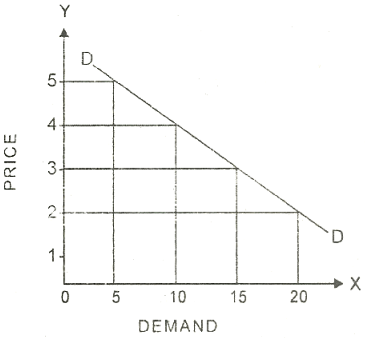The law of demand states that other things remaining constant, the quantity of a good demanded increases with a fall in the price and diminishes when the price increases.
Main Assumptions of the Law of Demand
- Prices of related goods do not change.
- Incomes of consumers do not change.
- Tastes and preferences of consumers remain constant.
- No expectation of the consumer to any change in the price of a commodity in the near future.
Demand Schedule and Market Schedule
A demand schedule is a chart or a table showing the quantities of a commodity demanded at various prices. The market demand schedule shows the total demand for the commodity in the market at various prices.
Individual Demand Curve and Market Demand Curve
The individual demand curve is a curve showing different quantities of a commodity that one particular buyer is willing to buy at different possible prices of the commodity at a point in time. In the diagram, the quantity of a commodity is given on the x-axis and the price on the y-axis. DD is the demand curve representing the individual demand schedule. The demand curve slopes downwards from left to right, indicating an inverse relationship between the price and the quantity demanded.

The market demand curve is the horizontal summation of the individual demand curves. It indicates various quantities of a commodity that all consumers in the market are willing to buy at different possible prices of the commodity at a point of time.
Why does the demand curve slope downwards to the right?
The demand curve slopes downwards because more goods are purchased in response to a fall in price. Thus, there is an inverse relationship between the price of a good and it’s the quantity demanded.
Factors responsible for the downward sloping demand curve:
- Law of diminishing marginal utility: The additional utility that the consumer derives from the additional consumption of any commodity is known as marginal utility. A consumer gets maximum satisfaction from the consumption of a commodity when the price paid for the commodity is just equal to its marginal utility. If the consumer consumes more of that commodity at any given time period, the marginal utility will gradually fall. This is called the law of diminishing marginal utility.
- Substitution effect: Substitution of one commodity for the other when it becomes relatively cheaper.
- Income effect: A change in quantity demanded when real income of the buyer changes as a result of change in price of the commodity.
Exceptions to the Law of Demand
- Giffen effect: A typical inferior commodity consumed by poor people may display an odd behaviour. When the price of such a commodity rises, the poor people may cut down on their purchases of other expensive items and increase their purchases of this commodity.
- Bandwagon effect: The bandwagon effect means that the consumer’s demand for a commodity is influenced by the taste and preference of the social class to which the consumer belongs.
Related Articles
Meaning and Functions of Money
Follow us